Corrugated pipe usually used in non-residential utility rooms(such as an attic) because the pipe is not aesthetically pleasing. Most often, a corrugated pipe is used for wiring from a switchboard to apartments. For a private house, corrugated pipes are used as protection for cables and wires running along overhead power line To home. However, there is an option with colored corrugation, which is quite suitable for wiring indoors.
A small diagram of wiring in a corrugated pipe
The beginning of the installation of the corrugations is the drawing up of a drawing diagram. Remember, pipes cannot be crossed with each other. Firstly, it is not aesthetically pleasing, and secondly, it is contrary to safety requirements. Therefore, first carefully draw a diagram of the entire piping of future wiring, excluding intersections with each other. After the drawing is drawn up, we proceed to the purchase of all material and accessories, right amount corrugated pipe. Let's start marking.
The diameter of the corrugated pipe must be determined correctly, for this we take the entire number of wires that will need to be carried inside the pipe and check on a piece of pipe so that they all fit. The void must be at least half the internal volume of the corrugated pipe, otherwise it will be difficult or even impossible to pull the wires.
How to thread wiring into a corrugated pipe
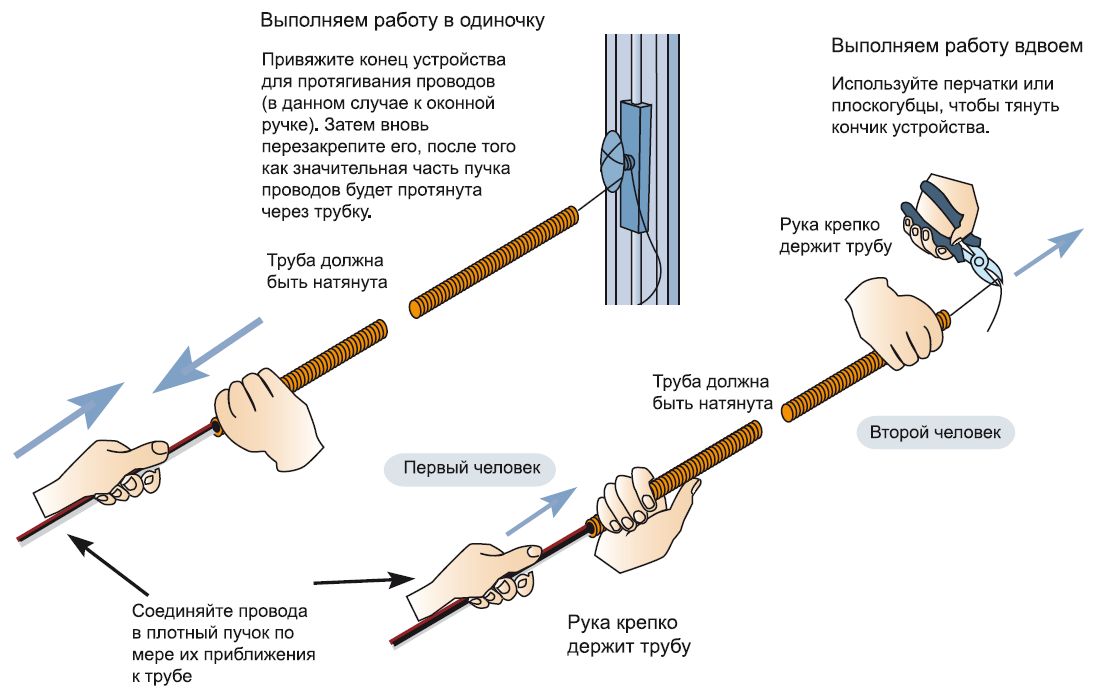
Corrugations come with a probe and without it. If there are small areas, you can use a corrugation without a probe. If the length of the wire to be threaded into the corrugation is very long, then the corrugation is needed with a probe wire.
How is the wire drawn.
We tie the end of the cable to the end of the probe wire, the pipe is tightly wrapped around the hand. Behind the other end of the wire, the wire is pulled through the corrugation. Several cables must be tied at the same time, while the pulling pipe must be straightened. Marking is done and points are marked for drilling holes for corrugation fasteners. Often in open method When laying a corrugated pipe, plastic clips are used, which are fixed to the ceiling and walls with the help of dowel-nails and screws.
With a corrugated pipe diameter of 16 mm, fasteners are placed at a distance of 30–40 cm. A corrugation with a diameter of 32, 40 mm requires the location of clips with a distance of 20–30 cm from each other. Then all the holes are drilled, a plastic dowel is inserted into them and screws are screwed in that press the clips. Next, the corrugation with wires is inserted into the clip. To disconnect the corrugation, simply pull the pipe towards you.
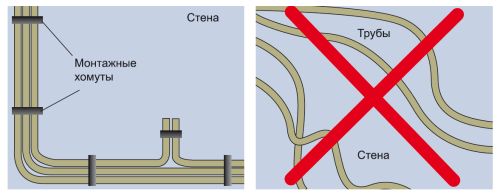
There are fastening options with a metal bracket and a retractable clamp. If the appearance of the pipe does not matter, you can use a tightening clamp, this option is also convenient if installation needs to be done quickly. With one clamp, fastened with a dowel-nail, a screw, it is possible to connect several corrugations that are tightened with a clamp.
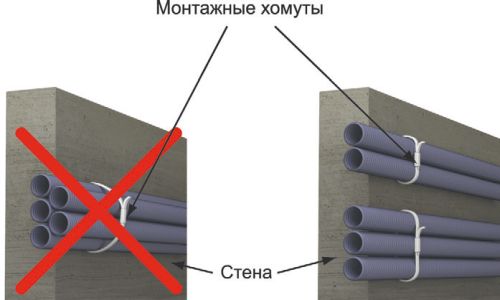
metal hose in living rooms not applicable, located only in technical rooms. The metal hose is mainly used in laying information cables(Internet, TV cable). thus, the metal hose acts as a screen for external electromagnetic radiation, the pipe must be grounded.
PVC pipes mounted in the same way as corrugated ones. They are used in utility and non-residential premises where additional mechanical protection is required for wiring. Clips or other type of fastening can be placed less often than in the case of a corrugated pipe, since pvc pipes Holds well and doesn't flex.
Step 1. The marking of the wall is done with the help of a beating - a colored thread.
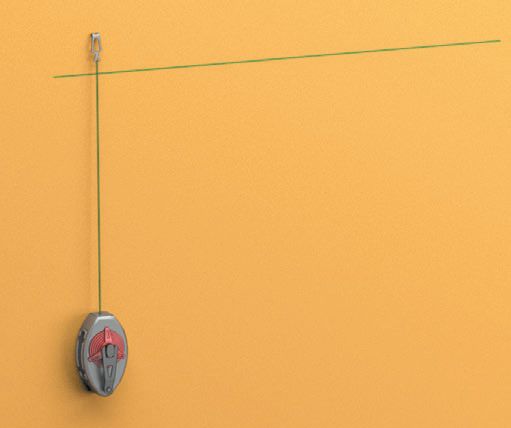
Step 2 Installation of installation and soldering boxes.
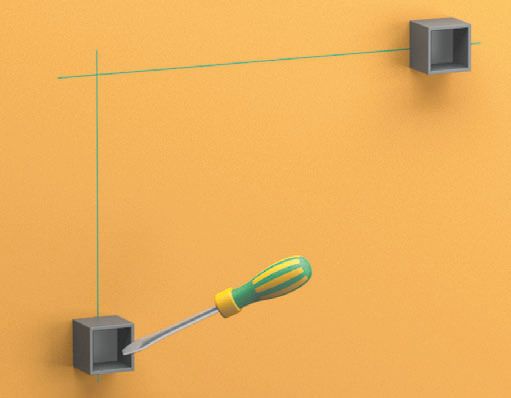
Step 3 The places for attaching clips for future pipe laying are marked.
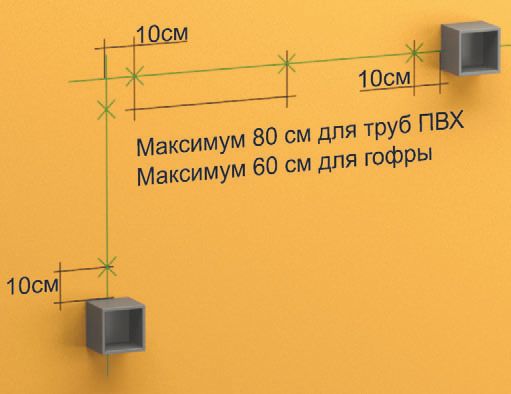
Step 4 Clip installation.
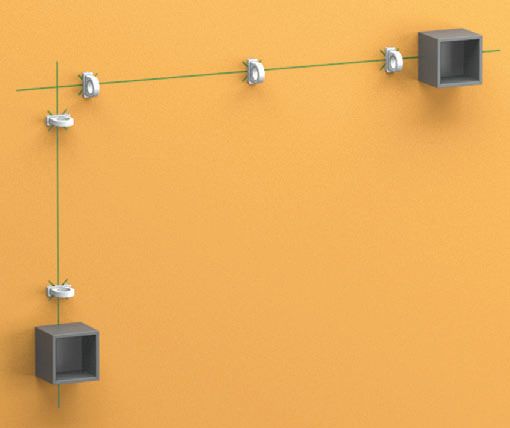
Step 5 The pipes are cut into several pieces of the required length, and then strengthened into clips, adjusting the dimensions of the accessories.
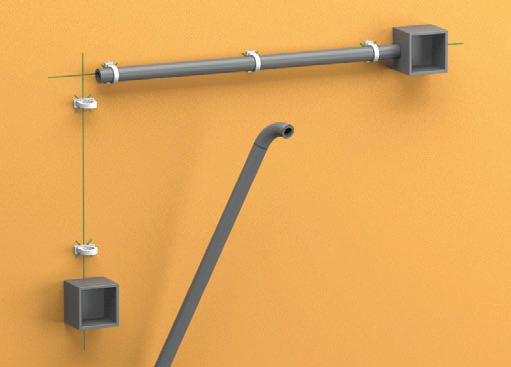
Step 6 The wire is pulled through the pipes and finally installed.
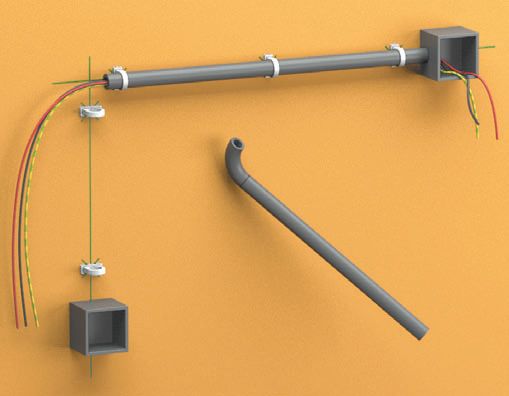
When reconstructing wiring or installing a new one, it is recommended to “pack” it in a protective sheath. Most often, corrugated electrical pipes are used, which are usually called "corrugations for cables and wires." It is a round hose with a ribbed surface. Due to the ribbing, its flexibility is significantly increased.
Why do you need a corrugation
In general, from mechanical destruction of the corrugation, even metal, - not best defense. One can only hope that, having felt that the drill has failed, it will be possible to stop in time. And in order not to get into the electrical wiring, it is better to have an exact plan for laying it with measurements and binding to the corners. After all, not everyone determines the cable in the corrugation, even under load. So do not forget before pouring the screed, before finishing, take pictures, sketch the distances.
Types of corrugations for laying cables
The corrugation for the cable is different in strength:
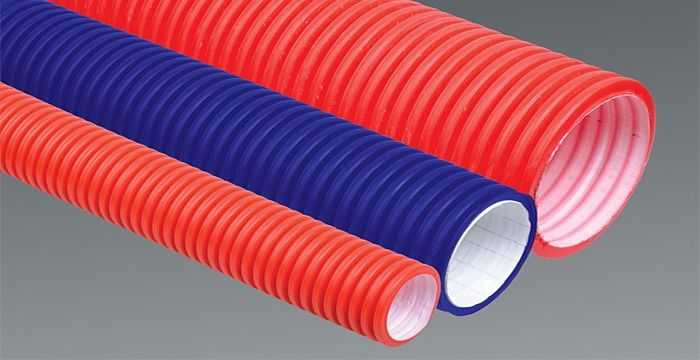
In addition to all this, there is also a corrugation with and without broach. A broach is a thin cable or wire that facilitates pulling the cable into the corrugation. The cable is tied to the end of the cable, pulled by its other end, tucking the cable inward. It is problematic to cope with this task without a broach - with sufficient rigidity, several meters of cable can simply be pushed inside, but if the route is long, it will be too difficult.
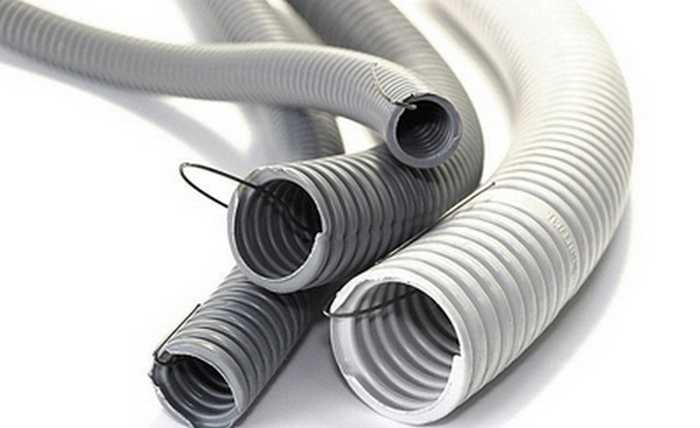
Cable corrugation can be with a broach (the correct name is "probe") and without
If we talk about the types of plastic corrugations, it should be mentioned that there is a two-layer corrugation. Outside, it has the same ribbed surface, but inside it is smooth. Corrugation for this type of cable is expensive, but if necessary, it can really be stretched into it new cable. In those types where the inner wall is ribbed, this is far from always possible - if the track has a minimum of turns, and even those along a wide radius.

Metal corrugation for cables is also different. It is made from galvanized or stainless steel. In addition, there is a metal corrugation with polymer coated. She has best performance protection against dust and moisture ingress. Such a protective shell is also called metal-polymer.
What materials
Corrugation for cable and electrical wires made of plastic and metal. The materials used are different different characteristics. They must be selected based on the tasks that they must perform.
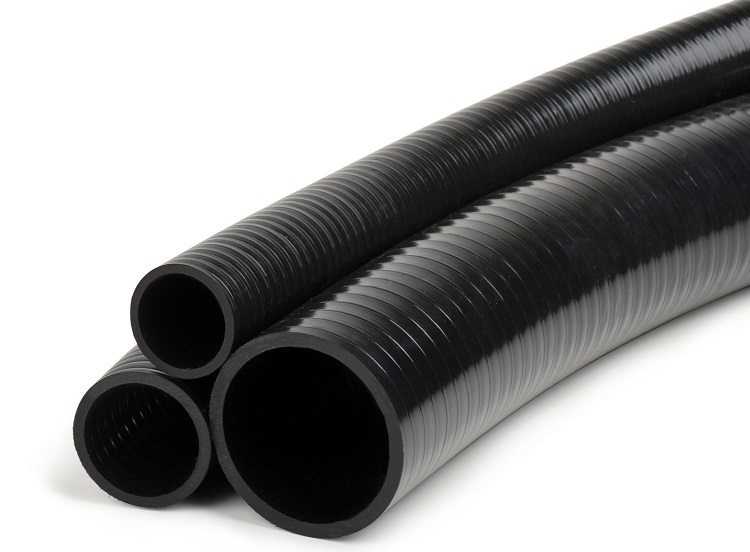
When it comes to compliance fire safety when installing the gasket in combustible walls, perfect option — metal pipe. It saves from the loads that may arise when changing the size of the building. Rodents cannot cope with it either. Also this the best way from the point of view of fire safety: even in the event of short-circuit currents and failure, the probability of burning a pipe with a wall thickness of 2 mm is very small. So the fire won't start. If the laying of electrical cables in pipes does not appeal to you at all, then you can use metal or stainless steel or galvanized corrugations.
Corrugation for cable, dimensions, prices
Corrugated pipes for electrical networks are available in sizes from 16 mm to 65 mm. When choosing a size, it should be borne in mind that these products have two diameters - outer and inner. If you are going to lay several conductors - wires or cables - the diameter must be selected so that there is a gap of at least half the radius. This requirement is based on the fact that during group laying (it is necessary, by the way, to take a special cable), it will heat up more and the presence air gap will promote better heat dissipation.

Size selection
The choice of corrugation diameter also depends on the area where it will be laid:
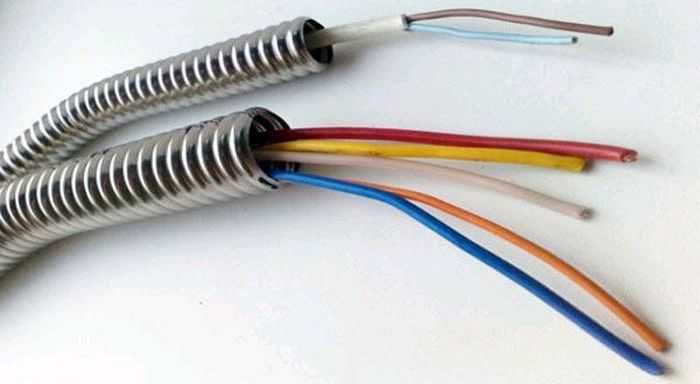
The diameter of the corrugation for laying the cable is selected depending on the number and cross section of the wires. Data for copper conductors are given in the table.
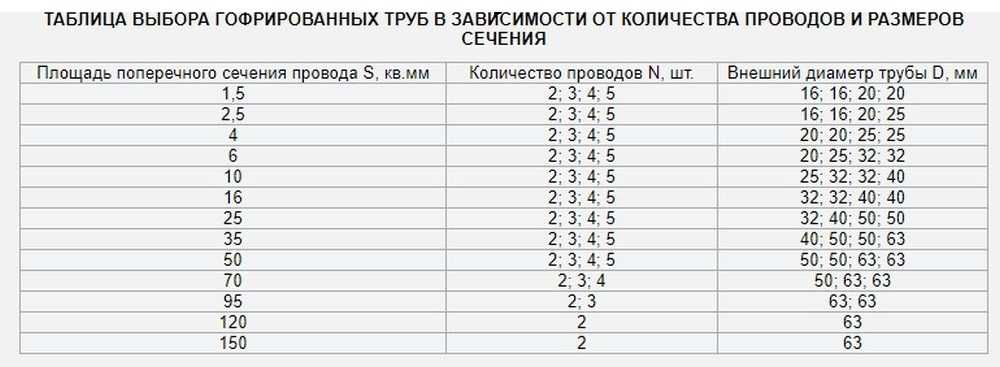
This information is for reference, but you can navigate it. You can take a larger, but not a smaller diameter.
Prices
Generally speaking, the cheapest is corrugation for PVC cable, in the middle range - PP and HDPE, the most expensive of all - metal corrugated. Moreover, the option with broach is slightly more expensive than without it. When buying, you need to pay attention to the same wall thickness, to the uniformity of color.

Corrugation for cable is sold in coils of 50 and 100 meters, less often it can be found in meters, but then the price is slightly higher. In general, the price depends not only on the material, but also on the wall thickness. The cheapest is the lightest PVC corrugation for cable, but sometimes it looks more like just a film. From what it can protect, it is difficult to say. If you are concerned about quality, it is better to purchase everything related to electrics not in construction supermarkets such as Leroy, etc. and in specialized ones. The quality there is usually better, and the prices, if higher, are justified. In order for you to have an idea about the possible spread of prices, in the table we will summarize several types of corrugations with a brief technical description.
| Name | Type | External diameter | Inner diameter | broach | Price per meter | IP | Purpose |
|---|---|---|---|---|---|---|---|
| PVC corrugation | light | 16 mm | 11.4mm | Yes | 2.4 rub | ||
| DCS | 15.7mm | 11.3mm | Yes | from 7.5 rub/m | 55 | for concealed laying | |
| Pipe corrugated HDPE black | DCS | 19.5mm | 14.5mm | Yes | from 8.9 rub/m | 55 | for concealed wiring |
| Pipe HDPE red double-walled | tough | 50 mm | 41.5 mm | Yes | 78.5 rub/m | 44 | for concealed laying |
| Heavy HDPE pipe | heavy | 31 mm | 23.4mm | Yes | from 9.7 rub/m | 55 | hidden gasket |
| Pipe PPL (polypropylene) corrugated | light | 19.7mm | 14.8mm | Yes | from 28 rub/m | 55 | open, concealed gasket |
| Corrugated pipe polyamide | black | 21.2 mm | 16.8mm | No | from 52 rub/m | 68 | open, concealed laying, UV resistant |
| Corrugated pipe polyamide | gray | 21.2 mm | 16.8mm | Yes | from 48 rub/m | 68 | open, hidden gasket |
Installation of corrugated pipes
For outdoor (open) installation, special plastic clips are used to fasten the corrugations for cables and wires, which are selected according to outside diameter pipes. Clips are fixed after 20-30 cm on self-tapping screws or dowels - depending on the type of wall. A corrugation for the kbale is inserted into the installed clips, pressed until it clicks. When mounted in a strobe, it is fixed with plastic ties or dowel-ties. You can also use homemade fasteners - tin strips with nails or screws in the middle.
When designing a route, it is necessary to take into account the following recommendations. They proceed from the fact that the route should be without sharp turns - in order, if necessary, to tighten a new piece of cable. That's why:
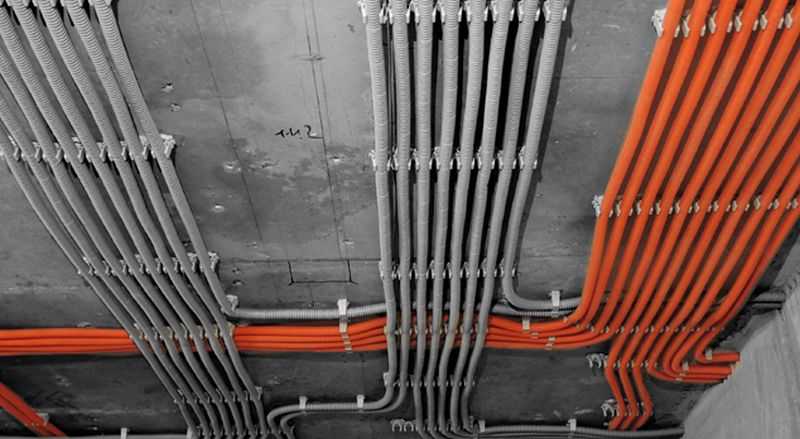
These rules relate to the development of a route for ground (suspension) and including. If the route is long, and you want to be able to pull the cable “in case of emergency” without replacing the corrugations, develop the route taking these rules into account.
Installation of wiring in the corrugation
When installing wiring in a house or apartment, pieces of corrugation are fixed between junction boxes, from them - to switches / sockets, to lighting fixtures. Here the sections are usually small, straight, with a maximum of one or two turns. So there are no problems with tightening the cable.
If several conductors are needed to be tightened into the corrugation for the cable, they are folded, fastened along the entire length with adhesive tape or electrical tape in increments of 30-50 cm (depending on stiffness). Rigid insulation is stripped from one edge by 10-15 cm, the wires are twisted into a common bundle, a loop is formed from it (secure the loop with tape or electrical tape, too). If the tourniquet is too thick, you can form the loops separately, just stretch the twine through everything. A cable is tied to this loop, and then they begin to pull it from opposite side pulling the sheath over the cables. At the same time, it is necessary to pull without jerking, smoothly - so as not to damage the cable or cable.
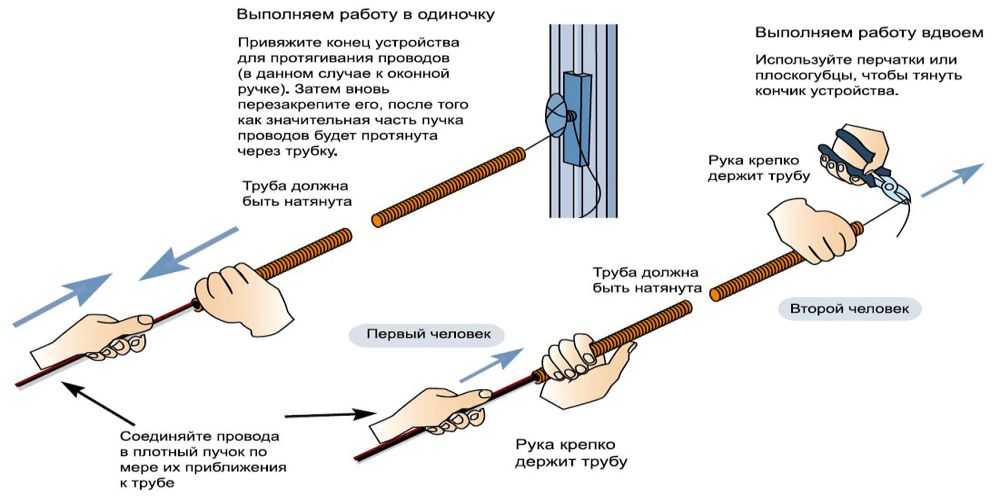
When installing, be careful not to slip the broach. To be sure, you can secure the cable with a piece of tape. There are two installation approaches:
- First fix the corrugation, then tighten the cable or wires into the finished piece.
- First stretch the cable, then mount it.
The first method is good for installation internal wiring, where the distances are small - from the box to the box, from the box to the outlet, etc. The second method is more suitable for installation of long sections.
Features of open laying on the street
When laying wiring on the street, it is usually suspended on a cable. For outdoor use, metal stainless steel is suitable, and better - metal-polymer corrugation for cable, as well as plastic polyamide (black or blue). All these materials are UV resistant and remain flexible at sub-zero temperatures.
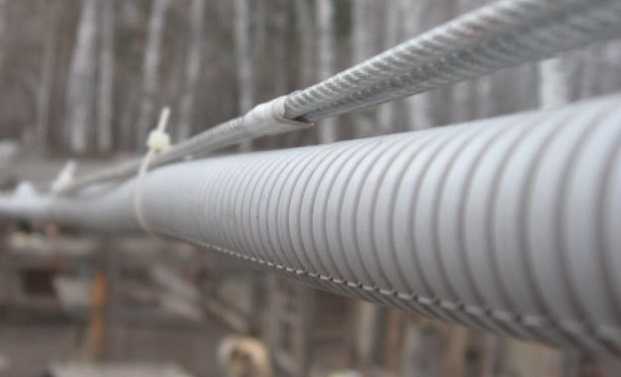
During installation, the cable stretched into the corrugation is suspended on a cable. The cheapest mount is ordinary plastic ties. There are also special hangers.
Add to bookmarks

The outer diameter is always indicated on the corrugation, therefore, the inner diameter will be smaller.
You can distinguish electrical corrugation and color. As a rule, it is produced by the domestic industry in shades of gray. Foreign counterparts may have blue, red and other colors.
When buying a corrugation, you should pay attention to the fact that the outer diameter is indicated. This means that the inner diameter can be at least a few millimeters smaller, and in some cases more than a cm.
The most popular diameters of such material for electrical wiring are all diameters ranging from 1.6 to 5 cm. It is much rarer to find diameters smaller or larger than the corresponding extreme values.
The corrugation is stored and sold in bays. The length of the pipe in one bay is directly dependent on the outer diameter. For example, for a diameter of 16 mm, the length of the pipe in the coil will be 100 m, for a diameter of 50 mm - 20 m.
Installation of electrical wiring in the corrugation
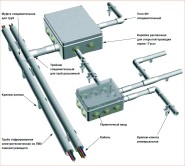
Corrugation for electrical wiring is made of non-combustible material, therefore, it can be mounted on almost any surface and on any structure.
Since the corrugation for electrical wiring is made of non-combustible material, it can be mounted on almost any surface and on any structure, including any wooden structure. There are frequent cases when the wiring is hidden in the corrugation, and it, in turn, under the skin wooden house. Such cases do occur, although it is recommended to use special smooth and rigid pipes in such a situation.
So, the installation begins with the fact that the required length of the pipe is cut off. You can make it normal sharp knife or a hacksaw with fine teeth. Steel wire is cut with side cutters.
Particular attention here must be paid to the wire. Since it has some tension, when it is cut, the end can "go" inward.
It will be possible to get it later, only once again cutting the pipe. To avoid such situations, the broach is slightly pulled and held during cutting, and then simply bent outward.
The second step is preparing the wiring harness itself. If there is only one wire, then no preparation is needed. If there are several, then they are simply fastened together with electrical tape along the entire length. It is best to use PVC duct tape, as it does not create unnecessary friction.
Next, the prepared tourniquet, more precisely, one of its ends, is securely connected to the broach. There are several ways here. Sometimes the broach simply wraps around the bundle and is crimped with pliers, sometimes the wire insulation is pierced with a broach, sometimes the broach is wound to the bundle with electrical tape - there are quite a few ways. In any case, the end of the bundle is wrapped with electrical tape so that the wires do not cling to the inner walls of the corrugation.
Next comes the moment of direct retraction of the bundle into the corrugation. If two people do this, then one simply holds the broach, and the second puts the corrugation on the tourniquet from above. If such work is done alone, then it is better to wind the broach with the second end to something.
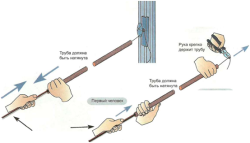
Fastening can be carried out using a special mounting strip made of aluminum.
In case of separation of the broach from the bundle, there is only one way out - to make a cut in the corrugation at the place of the break. In such a situation, the entire tourniquet will lie in a corrugation made up of pieces. Places of such cuts are recommended to be wrapped with PVC tape. To avoid such a situation, tighten the tourniquet monotonously and slowly.
After completing this procedure, the corrugation with the bundle inside is attached to something. Fastening can be carried out using a special mounting strip made of aluminum. You can use plastic clips. They are selected according to the diameter of the corrugation. Fasteners should be installed evenly, that is, through the same distance. This will help to avoid sagging of the corrugations in certain areas.
At the place where the wires enter the sockets, switches and other similar nodes, it is also recommended to hide the corrugation along with the wires. This is necessary so that no open sections of electrical wiring are formed. Specially for this installation are produced electrical sockets and switches with sealing rubber inserts. They are cut according to the diameter of the corrugation. This method of laying is especially relevant for external wiring.
It is worth noting that some believe that the use of corrugations is not acceptable from an aesthetic point of view. However, by performing its laying evenly and accurately, you can achieve its normal appearance, fitting into overall design interior. In addition, it is often the corrugation that becomes optimal solution for a summer residence or country house recreation in terms of savings, and wiring in corrugated pipes will never become a source of danger.
Recently in stock building materials a new element appeared - a corrugated pipe for underfloor heating. Performance characteristics of this material are significantly superior to those of pipes made of polypropylene and copper, and the main advantages of a corrugated pipe are its excellent strength and ease of installation.
Corrugated pipe is easy to install, durable and unpretentious
Important characteristics of pipes for underfloor heating
Laying a water-heated floor is carried out under a concrete screed, and therefore special requirements are imposed on the quality of the pipe, because to repair the damaged area, you will have to disassemble the floor, as well as break the concrete layer. That is why pipes for a water-heated floor must have a certain set of characteristics.
What should be the pipes for a water heated floor

Quality, long term services, ease of installation and unpretentiousness are obvious requirements that apply not only to the pipes themselves, but also to most other building materials and products. In addition to them, water pipes for underfloor heating must meet a number of other requirements:
- Reliability. It is believed that the life of the pipes should be comparable to the life of the building, and therefore be at least 50 years.
- Plastic. Water circuits are on average 60-120 meters long, and when laid they form many bends. That is why the pipes must be plastic, not damaged and not lose their qualities in the places of bending. In other words: the easier the pipe bends, the easier it will be to install.
- Impervious to oxygen. The entry of oxygen into the pipes - main reason corrosion and wall failure.
- Price. Enough is usually laid in the warm floor a large number of pipes, so their price should be affordable.
- Mechanical strength. Since the pipes are used on the floor, they must be able to withstand high mechanical loads. In cases where they mechanical strength low, experts recommend laying an additional layer of reinforcing mesh on top of them, protecting them from destruction.
Not all pipes for underfloor heating on the construction market meet all of the above requirements. Products made of cross-linked polyethylene, copper, metal-polymer pipes, as well as corrugated stainless pipe for underfloor heating. However, the latter has such advantages that make it the most desirable material for installing underfloor heating systems.
Advantages of corrugated water pipes
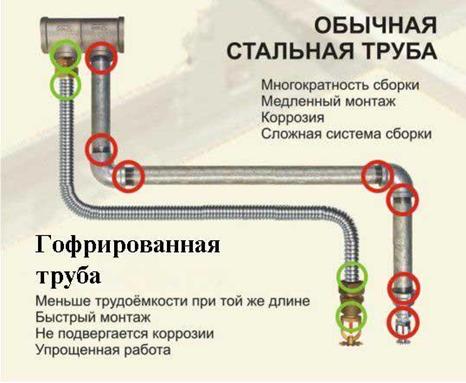
As mentioned above, the main advantages of corrugated water pipes are their strength and ease of installation. In addition, the metal corrugated pipe for underfloor heating has the following advantages:
- Undemanding. Unlike pipes made of copper and plastic, the corrugation does not need preventive cleaning and periodic replacement, so it can be safely poured with a thick layer of concrete or sewn up with panels.
- Security. The corrugated pipe is resistant to ultra-high temperatures and does not deform even from boiling water (which cannot be said about polymeric materials).
- Ease of installation. To install the pipe, no special equipment is required (for example, in the form of welding equipment and a soldering iron for connecting polypropylene pipes).
- Flexibility. Corrugated pipe for a warm water floor is easily bent under right angle, taking the necessary position and direction. Thanks to this, you can collect the most complex scheme underfloor heating without much effort and with a minimum amount of connecting fasteners.
- operational endurance. The corrugated pipe is resistant to corrosion, mold and development harmful microorganisms. She is also not afraid of rodent attacks, so she can be used in basements and in warehouses.
- Wear resistance. The corrugated pipe is able to withstand massive hydraulic shocks with pressures up to 65 bar.
- Versatility. Corrugated pipe for underfloor heating can act as heating radiators, as it has a very high thermal conductivity and heat transfer.
The choice of corrugated pipes for installation of the underfloor heating system
When buying a pipe for organizing a warm floor system in a house, you should pay attention not only to how it meets the requirements listed above; Equally important are also such characteristics as:
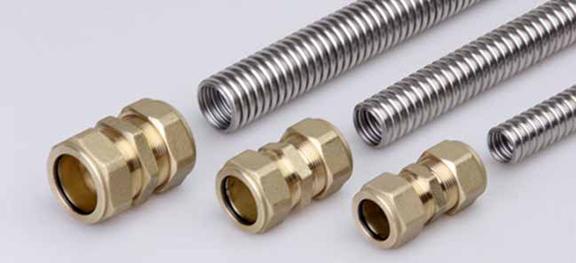
- Pipe length (bay footage). The pipe must be long enough to lay one circuit without additional connections. This will prevent potential water leaks at the fasteners, helping to create a more reliable and predictable system.
It is important to remember that maximum length pipe on the contour is limited by its diameter. So, the length of a circuit built with a pipe 16 mm in diameter should not exceed 70 meters; 20 mm in diameter - 90 meters; 25 mm in diameter - 120 meters.
- Pipe diameter. Pipes with a section of 16, 20, 25 mm are most in demand. Choosing between thick and thin pipe, it should be remembered that a thick pipe has a greater heat transfer, however, pouring such a pipe requires a much larger volume cement mixture, which, in turn, leads to an increase in the level of the floor and to an increase in the load on the flooring and ceilings.
- Manufacturer. The cost of the pipe, as well as its quality, differ depending on who made it. Today they are engaged in the production of corrugated pipes Russian manufacturers(Ruvinil, Neptun, Kofulso) South Korea(Lavita, Hydrosta), Germany (Meibes).
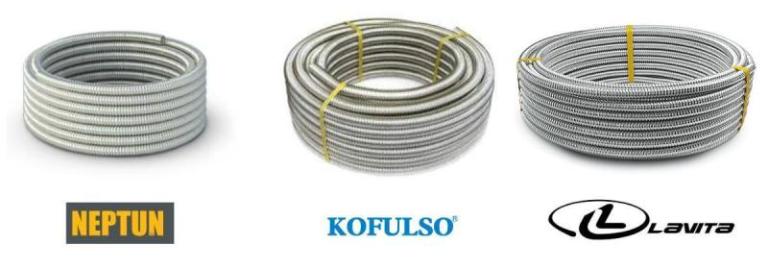
- Mechanical strength. This is one of essential requirements. Metal walls withstand not only pressure from the side concrete screed, but also internal pressure water in the circuit. At the time of emergency water hammer, the pipe must be able to withstand a pressure of 10 bar.
Installation of corrugated water pipes
Laying the contours of the warm floor system is not the best simple work, however, if you have experience with conventional metal or plastic pipes, even a beginner can do it.
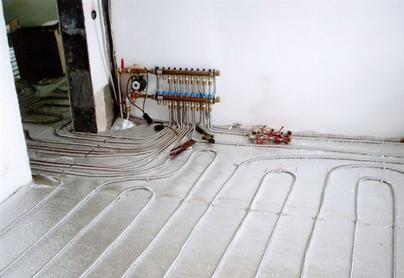
The sequence of actions for the installation of corrugated water pipes is as follows:
- First of all, it is necessary to waterproof the floor with a waterproofing membrane, rubber paint or finished composition based on plasticizers.
- After waterproofing, the floor surface is covered with expanded clay concrete or mortar screed.
- A reflector is laid out on top of the screed (for example, based on foil), and a metal mesh is placed on it.
- At a distance of 15 cm from the wall, a corrugated pipe is laid out (loop pitch - 20 cm) in accordance with the selected laying pattern.
When determining the loop pitch, you should know that the corrugated pipe warms up the floor surface at a distance of 10 cm, so a 20 cm loop completely covers a 40 cm wide area. To provide a zone with comfortable temperature the loop can be up to 30 cm wide.
- A corrugated pipe (stainless steel) for underfloor heating is attached to a metal mesh using a plastic tie, from which “tails” are cut off after installation.
- Before pouring, the system is pressure tested for 3 hours with a pressure of about 7 atm.
- Then beacons are placed on the floor surface.
- A screed solution is being prepared according to the selected recipe.
- The solution is poured to a height of 5 cm for every 20 cm of area.
- The screed dries for about 1 month (3 weeks in summer, a little over 4 weeks in the rest of the year).
- The first start of the system is carried out in two stages: for the first time, water is started at a temperature of no more than 25 degrees for 24 hours; at the second stage, the water temperature rises to 40 degrees, the screed is dried for several days, after which the warm floor is turned off.
- Tiling is being done.
You can get acquainted with the process of installing corrugated water pipes by watching this video.


















